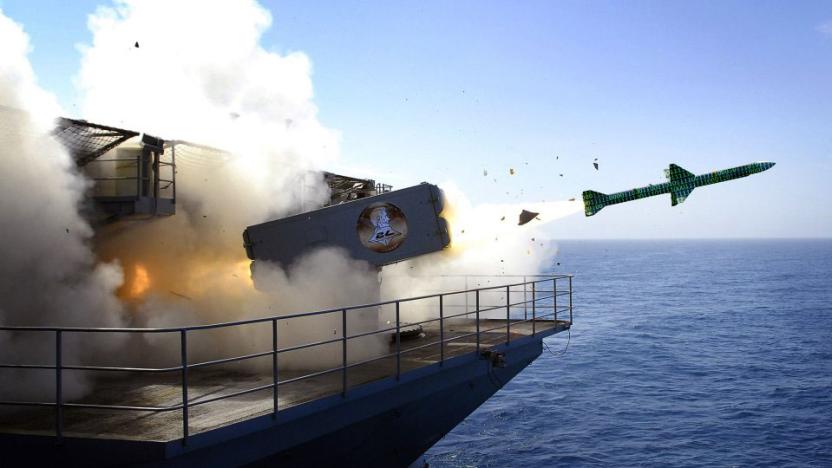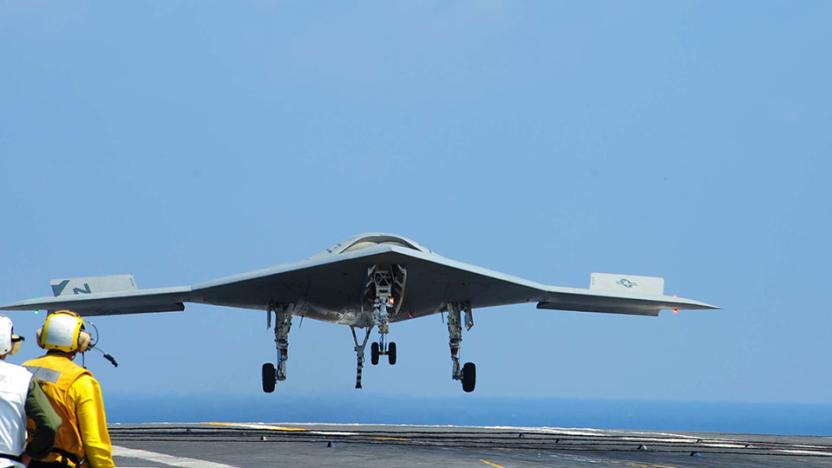Navy
Latest

US Navy's cheap and tiny Cicada drones can listen in on the enemy
The Navy's Cicada drone has reemerged looking smaller than ever. Navy scientists have been developing the tiny smart glider since 2006 and even performed a flight test back in 2011. This newest iteration, which has been presented at the Department of Defense's "Lab Day" last week, is the smallest one yet and can fit in the palm of your hand. The US Navy has always envisioned the Cicada drone, formally named Covert Autonomous Disposable Aircraft -- a completely different project from the Navy's LOCUST drones -- to be tiny, low-cost and ultimately disposable. Like the insect, it was designed to fly in swarms and do its job until it (or, technically, its battery) dies. Despite looking like an innocuous paper/plastic plane, it's loaded with sensors -- Agence France-Presse even calls it a "phone with wings."

US Navy fighter jets will carry an autonomous anti-ship missile
The US Navy may have a robotic ace in the hole when it fights enemy warships in the future. It's planning to put Lockheed Martin's autonomous LRASM (Long Range Anti-Ship Missile) on the F/A-18 Super Hornet by 2019, giving jet fighters a weapon that tracks and wipes out targets mostly or entirely on its own. Most of the missile's details are secret, but it's smart enough to dodge obstacles on the way to vessels as far as 200 nautical miles out -- and that's the unclassified range, which suggests that it's more capable in practice. There are also versions of LRASM in the works that will launch from ships, submarines and other aircraft, so this intelligent projectile could soon be a mainstay of the US military.

Navy researchers make bulletproof glass out of clay
The US Naval Research Laboratory announced a major breakthrough in materials science on Thursday. After decades of research and development, the NRL has created a transparent, bulletproof material that can be molded into virtually any shape. This material, known as Spinel, is made from a synthetic powdered clay that is heated and pressed under vacuum (aka sintered) into transparent sheets. "Spinel is actually a mineral, it's magnesium aluminate," Dr. Jas Sanghera, who leads the research, said in a statement. "The advantage is it's so much tougher, stronger, harder than glass. It provides better protection in more hostile environments -- so it can withstand sand and rain erosion."

The X-47B's first aerial refueling test will also be its last
The Navy's X-47B combat UAV demonstrator successfully paired with an an Omega Air KC-707 airtanker earlier this week. This marks the first time in aviation history for a UAV to demonstrate aerial refueling capabilities. Unfortunately, these tests also likely mark the end of the X-47B program. Despite only completing 20 percent of its potential flight hours, both of the Navy's X-47Bs are destined for museums. Still, the technologies that they've demonstrated -- including those historic autonomous carrier landings in 2013 -- will make their way into future unmanned combat aerial vehicles as part of the Navy's Unmanned Carrier-Launched Airborne Surveillance and Strike (UCLASS) program.

Prototype Navy drones swarm like locusts
The days of enormous, singular UAVs directly controlled by remote pilots may be coming to an end. Over the last few years, there's been a lot work towards developing smaller drones capable of autonomously coordinating their actions, much like insects do. Now, the Office of Naval Research (ONR) is taking these lessons and applying them to military uses, such as its new LOCUST (Low-Cost UAV Swarming Technology) program. It utilizes a rocket tube launcher filled with lightweight, self-guided Coyote UAVs that team up and overwhelm enemy aircraft like honey bees defending their hive.

The US Navy is taking cyber warfare to the enemy
The US Navy will soon operate as a cyber warfighting platform, ready to attack rogue nations when ordered by the White House. A top military commander tipped the initiative at a defense conference, saying "you don't win a knife fight without swinging a knife." US intelligence services already launch limited cyber strikes, as they did against North Korea following the Sony hacking incident. But assigning such attacks to a military arm is a signal that the US wants a stronger deterrent against hacking aggression from China, Russia and other nations. There's no word on whether the Navy's new role is part of the new US Cyber Threat Intelligence Integration Center initiative.

Duck-like US Navy drone can fly or swim to hunt submarines
There are plenty of flying and swimming drones, but you'd ideally have both at once for sub-hunting -- you want something that can poke its head underwater, but move quickly through the air when needed. The US Navy certainly knows this. It's developing a duck-like drone, the Flimmer, that can both fly and swim. In addition to both a rear-facing propeller and wings, its latest incarnation has four fins that adapt to what the robotic craft is doing. In flight, they serve as stabilizers and canard wings; in the sea, they flap to give the machine a speed boost.

US Navy's latest diving suit saves helium, space and weight
The US Navy has just unveiled a new diving suit prototype, and aside from being more efficient than older models, it also helps conserve helium. See, the agency's current suit uses Fly-Away Mixed Gas System (FMGS), which releases gases the diver exhales into the sea, including huge amounts of oxygen and helium. According to the Navy scientists that designed the new version, it "modifies the current helmet and rebreather," and tests prove that it can drastically reduce the consumption of the noble gas-- important in the midst of a global helium shortage. While we can make do without balloons or squeaky voices in parties, the gas is also used for more important purposes, such as operating MRI machines and the Large Hadron Collider.

The Navy's unmanned drone project gets pushed back a year
For the last few years, the Navy has been working on UCASS, a project to build a drone that'll replace surveillance and attack craft with one vehicle. We've already seen the X-47B demonstrate its ability to fly with manned squadrons and land on a carrier, but it looks as if we won't be seeing it in action until 2023 at the earliest. Unfortunately, it transpires that those higher up the chain have raised concerns about the project's cost and capability, and work isn't scheduled to begin until next year at the very earliest.

US Navy's firefighting robot finally appears (with a trusty sidekick)
SAFFiR, the humanoid firefighting robot that the US Navy and Virginia Tech engineers have been developing for years, is now more than just a blueprint. In fact, the military division has already demonstrated what the biped can do aboard one of its decommissioned ships. During a series of tests conducted in November 2014, it worked well enough to navigate uneven floors (extremely difficult for humanoid machines), identify equipment using thermal imaging and handle a hose to put out small fires. The Shipboard Autonomous Firefighting Robot did need a bit of help from a sidekick, though. No, not the firefighting snakebot Anna Konda (which is unfortunate, if you think they're the perfect pair), but a small drone created by Carnegie Mellon's Robotics Institute.

Navy drone swims like a shark to spy on foes
It's hard to covertly gather intelligence on the open seas; conventional drones and submarines make it rather obvious that something's up. The US Navy might just have a stealthier option with its experimental GhostSwimmer drone, which recently finished tests. The five-foot-long robot looks and swims much like a shark, letting it spy on enemies (or inspect friendly ships) without being conspicuous -- as long as curious foes don't get too close, anyway. It goes as deep as 300 feet, and it can operate autonomously for long enough that the Navy doesn't have to stay nearby to keep watch.

China has a microwave pain weapon of its own
The US may never have used its microwave pain gun in combat, but that isn't stopping China from exploring the concept of non-lethal force. Local manufacturer Poly has unveiled the WB-1, a millimeter-wave weapon that heats the water under your skin (much like the US' Active Denial System) to deliver intense agony without injury. It currently works at a relatively short range of about 262 feet, but extra power can bump that up to 0.6 miles -- if you know where to shoot, you could cause misery from afar. It's reportedly meant to be used on the high seas, where it could enforce China's territorial claims without the need to capture or destroy wayward vessels.

US Navy puts its first laser weapon into service
It's official: the US Navy has entered the future. Vice Admiral John Miller tells Bloomberg that the USS Ponce, an amphibious transport, has been using the Navy's Laser Weapon System (LaWS) in the Persian Gulf since late August. The high-tech arsenal is no threat to larger vessels, but it's potentially ideal for defending against Iran's fleet of smaller ships. The Ponce can use non-lethal laser flashes to spook enemies or thwart their sensors, and it can destroy small craft (including airborne drones) if they don't heed warnings. It'll take some time before laser weapons are a common sight on the high seas, since the Navy wants to know how it fares in real-world conditions; dust, heat and other Gulf conditions could lead to failures. If it pans out, however, there's a real chance that the days of conventional small deck guns are numbered. [Image credit: John F. Williams/US Navy, Flickr]

A minesweeping robot boat will protect the Navy's expensive new baby
We first heard the Navy was developing a minesweeping robot boat last year, but now it's closer to a reality. Dubbed the Unmanned Influence Sweep System (UISS), it'll accompany the Navy's new, high-tech Littoral Combat Ship (LCS) to explore and detonate explosives in suspected minefields. The Navy tapped Textron Systems last September to develop a UISS prototype for 2016, along with six complete ships by 2019. While it's not our military's first robotic vessel, it may end up being one of the first that's more than a glorified patrol ship.

Doctors report a case of Google Glass addiction
You've probably heard of Google Glass owners who seemingly can't put the wearable down, but there's now at least one reported instance of genuinely addictive behavior. Doctors at Naval Medical Center San Diego claim that a 31-year-old Navy serviceman is the first person to be diagnosed with a Glass-related internet addiction disorder. The patient wore the head-mounted computer for up to 18 hours a day, and was so attached to it that he would instinctively reach for his right temple (to activate Glass) whenever you asked him a question, whether or not the device was there. He's getting better after having spent 35 days in on-site treatment, according to doctors; that reflexive movement doesn't come up so often, and the man is both less irritable and more focused.

Watch the US Navy's swarm of robotic boats take to the sea
Overwhelming numbers can help win a sea battle, but sailors are far too valuable to simply throw away -- and the US Navy knows it. To that end, it recently tested a swarm of robotic gunboats that work in tandem to either protect a main warship or surround the enemy. As you can see in the video below, they're very well coordinated. The vehicles' Control Architecture for Robotic Agent Command and Sensing (CARACaS) lets them both operate independently while sharing their paths and radar data with each other, keeping them both out of each others' way and aware of any potential threats.

Octopus-like camouflage can hide you in plain sight
Octopuses and other cephalopods are masters of disguise -- their prey often doesn't realize the danger until it's too late. It only makes sense to model active camouflage after that behavior, then, and a team at the University of Illinois has managed just that. Their octopus-like material uses layers of photosensors, actuators and temperature-sensitive pigment to detect ambient light and change colors in response. Individual points on the unversity's test skin can turn from black to transparent within a second or two, letting it quickly blend into its surroundings -- or purposefully stand out, as you see above. The technology will ideally allow for many colors in the future, although that's not an immediate priority.

Lockheed Martin's FORTIS exoskeleton helps US Navy with heavy lifting
While it may not be a full suit of high-tech gadgetry like Iron Man dons, the US Navy is set to test exoskeletons from Lockheed Martin. In the first contract to employs the company's strength-boosting garb for industrial use, two FORTIS exoskeletons will help carry heavy loads for the trial period. The lightweight unpowered option lends endurance by using the ground to help bear the mass. During the testing phase, the company hopes to further develop the tech for use at Navy shipyards where a smattering of heavy tools are needed for maintenance. "By wearing the FORTIS exoskeleton, operators can hold the weight of those heavy tools for extended periods of time with reduced fatigue," said Adam Mill, director of new initiatives at Lockheed Martin Missiles and Fire Control.

Navy sailor pleads guilty to hacking from an aircraft carrier
You may think that the US Navy's biggest digital threats come from the outside, but that's not always the case. Former Navy serviceman (and leader of the hacking group Team Digi7al) Nicholas Paul Knight has pleaded guilty to charges that he and co-defendant Daniel Kreuger conspired to steal identities from numerous internet sites, including a Navy personnel relocation system. Knight was caught after investigators realized that someone in Digi7al was posting on Twitter from the Navy's internal network -- as it turns out, the sailor was breaking into databases while he was a system administrator aboard the aircraft carrier USS Harry S. Truman.

Watch Lockheed Martin's laser weapon take down boats from a mile away
It's good that Lockheed Martin's ADAM laser can shoot down drones and rockets, but there are threats much closer to Earth -- say, small boat crews bent on destroying large warships. Never fear, though, as we now know that ADAM can take care of those targets as well. Lockheed has successfully wielded the weapon against small boats, burning holes through their rubber hulls from a full mile away. The laser's automatic infrared tracking makes targeting a piece of cake. Even with the pitching of the waves, it's easy to aim at a specific point on a vessel.






